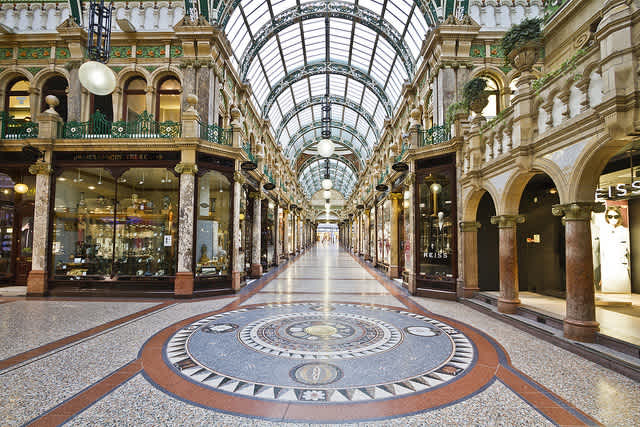iBeacon is basically a communication protocol developed by Apple‚ introduced at the Apple Worldwide Developers Conference back in 2013. iBeacon-compatible hardware transmitters – known as beacons – are a class of Bluetooth low energy devices‚ which broadcast their identifier to nearby portable electronic devices.
The transmitters come in a variety of form factors‚ such as USB sticks‚ small coin cell devices‚ and generic Bluetooth 4.0 capable USB. With the help of an iBeacon‚ a smartphone’s software can easily find its relative location in a store.
Retail stores use beacons for mobile commerce‚ offering customers special deals through mobile marketing‚ and enabling mobile payments through point of sale systems.
iBeacon Technology
![[object Object] [object Object]](http://images.ctfassets.net/o6514hijae09/gnsQ6FdY4vT8ZKziH4dBZ/da9aae3d1a7812ab28c00b4f68a4c674/13570805343_e6deb57644_z.jpg)
Source: Flickr
iBeacon uses Bluetooth low energy proximity sensing to transmit a unique identifier‚ picked up by a compatible app or operating system. The identifier and several bytes sent with it can be used to determine the device’s physical location‚ track customers‚ or trigger a location-based action on the device‚ such as a check-in on social media or a push notification.
This differs from some other location-based technologies‚ as the broadcasting device beacon is only a one way transmitter to the receiving device. A specific app must be installed on the device to interact with the beacons. This ensures that only the installed app – not the iBeacon transmitter itself – can track users‚ potentially against their will‚ as they walk around the transmitters.
![[object Object] [object Object]](http://images.ctfassets.net/o6514hijae09/6VLV3TC16P5bvcQeALmGCI/806218b3ac345bd8c9edc31811b6fdf8/13571106354_d90c14ddfe_z.jpg)
Source: Flickr
The primary use of iBeacons tends to centre around improving the in-store shopping experience‚ by way of context-driven content directed to a shopper’s phone. This might take the form of personalised offers‚ in-store maps‚ and so on – the possibilities are really endless.
The modern use of mannequins
![[object Object] [object Object]](http://images.ctfassets.net/o6514hijae09/4Ow8CLQWdbYGeUQSHr6G35/3dafc979f8db44865470f5e098ec5cf3/6517018785_1b38149fbb_z-2.jpg)
Source: Flickr
For years‚ mannequins have been used in retail environments to display clothes and attract customers. Now‚ they are being geared up to connect and engage with shoppers‚ by integrating iBeacon technology into the mannequins.
![[object Object] [object Object]](http://images.ctfassets.net/o6514hijae09/YGNxjuiAVvN3bvB2dIGH1/caa5ed2da78a933d4d887cf044e39233/6517027957_1cca312100_z.jpg)
Source: Flickr
These iBeacon-enabled mannequins will trigger notifications on the customers’ smartphones or iPads‚ when they are within a 50-metre range. This will include information about the clothing items on display‚ such as prices and where they can be found in-store. In doing so‚ the mannequins will both heighten consumer engagement and drive further sales.
![[object Object] [object Object]](http://images.ctfassets.net/o6514hijae09/yzGiS1M2KNSnuPI8fqNSK/30e01a7822fb708dea2e140019a82d24/15051662336_fa7ff66238_z.jpg)
Source: Flickr
These notifications could also give the retailer an opportunity to showcase exclusive online products from various brands. The service could allow customers to share the product with friends through social media‚ save them for purchase later or buy direct from the online store. Offers and rewards will also be accessible through this service.
The future of retail
![[object Object] [object Object]](http://images.ctfassets.net/o6514hijae09/72WnC9HOmVCdf62B4k6ebZ/e84635bdc247b8dc59124018ddae3a2b/2153666905_26b5641981_z.jpg)
Source: Flickr
Some of the leading high street brands like House of Fraser‚ Waitress‚ Hamleys‚ Armani‚ Longchamp and Hackett are already harnessing this technology. According to Business Insider report this $4 billion market in 2015 has tremendous projections of $44 billion for the year 2016.
iBeacon-enabled mannequins strike a balance between customers’ expectations and their constraints‚ by engaging them with contextual notifications about prices and offers. For the retailer‚ they also provide valuable insights into customer shopping behaviour‚ the customer journey‚ as well as the in-store experience.
Installing iBeacons within mannequins or other in-store displays could therefore feed into the product development cycle‚ providing retailers with an agile means of gathering feedback on products‚ so they can improve features over time.
Information about purchasing patterns and consumer tastes will also allow businesses to customise their product offerings‚ and the notifications they send to different demographics.
For example‚ if a customer is looking for an item in a particular size‚ colour or design‚ the retailer can send information about existing stock if it is available‚ or send an alert when new stock arrives. They may also suggest a combination of accessories that complement their outfit‚ to upsell a range of products.
Moreover‚ virtual mannequins could act as an extension to the physical ones. They enable a 24/7 shopping experience to consumers‚ enabling buyers to try their favourite dresses on these virtual mannequins and make a purchasing decision there and then. They can check out in the ecommerce portal of the shop with their selected merchandise.
If done correctly‚ beacons could create a connected‚ in-store environment that is subtle and ubiquitous‚ providing a round-the-clock shopping experience to customers in a retail environment. Contextual and non-intrusive push notifications will engage consumers more than ever before and could soon be a crucial part of all major brands’ retail mobile strategy. By learning about customer behaviour and tailoring in-store marketing‚ retailors can convert more window shoppers into actual ones.
References
1. Hawes & Curtis‚ House of Fraser and Bentalls install beacon-enabled mannequins






